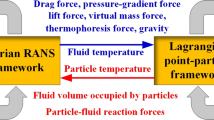Abstract
A simple one-dimensional planar model for ejection was set up based on experiments. And numerical simulation was performed on this model with particle trajectory model method. An Eulerian finite volume method was conducted to resolve gas field. And Lagrangian method was imposed to track each particle. The interaction between gas and particles was responded as source terms in governing equations which were induced by forces. The effects of total spraying mass, particle size and other factors on the mixture of particles and gas were investigated. The spatial distributions of particle mass and velocity at different time were presented. The result shows that the numerical results are qualitatively consistent to those of experiments.
Similar content being viewed by others

References
WALSH J M, SHREFFLER R G, WILLING F J, et al. Limiting conditions for jet formation in high velocity collisions[J]. J Appl Phys, 1953, 24: 349–359.
THOMPSON B J. Holographic measurement of eject from shocked metal surface[J]. J Appl Phys, 1965, 14: 302–308.
ASAY J R, MIX L P, PERRY F C. Ejection of material from shocked surfaces[J]. Applied Physics Letters, 1976, 29(5): 284–287.
XU Guang-wen, GE Wei, LI Jing-hai. Prospects of modeling particle-fluid two-phase flow[J]. Journal of Basic Science and Engineering, 1994, 2(2/3): 139–146. (in Chinese)
YUAN Ya-xiong, YANG Jun-yun. The interior ballistic particle trajectory model and ita numerical calculation[J]. Journal of Ballistics, 1995, 7(4): 7–12. (in Chinese)
TIAN Z F, TU J Y, YEOH G H. Numerical modeling and validation of gas-particle flow in an in-line tube bank[J]. Computers and Chemical Engineering, 2007, 31: 1064–1072.
CHEN Xiang-hui, MCLAURY B S, SHIRAZI S A. Numerical and experimental investigation of the relative erosion severity between plugged and elbows in dilute gas/solid two-phase flow[J]. Wear, 2006, 261: 715–729.
ZHOU Hao, CEN Ke-fa, FAN Jian-ren. Detached eddy simulation of particle dispersion in a gas-solid two-phase fuel rich/lean burner flow[J]. Fuel, 2005, 85: 723–731.
CHUANG M S, LEE S J, CHANG K S. Effect of interfacial pressure jump and virtual mass terms on sound wave propagation in the two-phase flow[J]. Journal of Sound and Vibration, 2001, 244(4): 717–728
HUANG She-hua, LI Wei. On added mass force acting on a small particle moving unsteadily in viscous flow[J]. Engineering Journal of Wuhan University, 2002, 35(4): 13–17. (in Chinese)
WAKABA L, BALACHANDAR S. On the added mass force at finite Reynolds and acceleration numbers[J]. Theor Comput Fluid Dyn, 2007, 21: 147–153.
YOU Chang-fu, QI Hai-ying, XU Xu-chang. Progress and application of Basset force[J]. Chinese Journal of Applied Mechanics, 2002, 19(2): 31–35. (in Chinese)
HUANG She-hua, LI Wei, CHENG Liang-jun. On numerical method of resolving discrete solid particles motion equation and its applications[J]. Journal of Hydrodynamics: Ser A, 1999, 14(1): 51–61. (in Chinese)
ZHANG Jian-ping, LI Yong, FAN L S. Numerical studies of bubble and particle dynamics in a three-phase fluidized bed at elevated pressures[J]. Powder Technology, 2000, 112: 46–56.
DOLGONOSOV B M. Numerical simulation of the formation of a dispersed phase with particle coagulation and breaking[J]. Theoretical Foundations of Chemical Engineering, 2002, 36(6): 539–545.
GUO Lie-jing. Two-phase and multi-phase fluid dynamics[M]. Xi’an: Xi’an Jiaotong University Press, 2002. (in Chinese)
TONG Bing-gang, KONG Xiang-yan, DENG Guo-hua. Aerodynamics[M]. Beijing: High Education Press, 1989. (in Chinese)
ENGQUIST B, OSHER S. One sided difference approximation for nonlinear conservation laws[J]. Math Comp, 1981, 36: 321–351.
OSHER S, SOLOMON F. Upwind difference schemes for hyperbolic conservation laws[J]. Math Comp, 1982, 38: 339–374.
QIU Jian-xian, KHOO B C, SHU S W. A numerical study for the performance of the Runge-Kutta discontinuous Galerkin method based on different numerical fluxes[J]. Journal of Computational Physics, 2006, 212: 540–565.
Author information
Authors and Affiliations
Corresponding author
Additional information
Foundation item: Project(10672151) supported by the National Natural Science Foundation of China
Rights and permissions
About this article
Cite this article
Liu, K., Bai, Js. & Li, P. Application of particle trajectory model in 1D planar ejection. J. Cent. South Univ. Technol. 15 (Suppl 1), 149–154 (2008). https://doi.org/10.1007/s11771-008-0335-x
Received:
Accepted:
Published:
Issue Date:
DOI: https://doi.org/10.1007/s11771-008-0335-x



